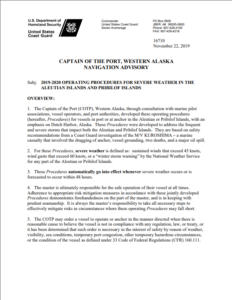The USCG issued an advisory bulletin providing guidance for vessels transiting through the Aleutian and Pribilof Islands, considering the challenging weather conditions and the incidents that have taken place.
According to the bulletin, the procedures explained below should go into effect whenever any severe weather occurs or is forecasted to occur within 48 hours.
It is always the master’s responsibility to take all necessary steps to effectively mitigate risks in circumstances where these operating Procedures may fall short.
Specifically, the factors anyone should consider to determine whether a vessel poses excessive risk, include:
- vessel location
- on scene weather
- machinery/equipment status
- dragging anchor
- vessel load status (to determine draft/free surface area)
- cargo stowage (ready for sea)
- number of vessels alongside or scheduled alongside
- estimated duration of cargo operation
- availability of resources (tugs, pilots, available dock space, etc.).
Moreover, it is advised that vessels at anchor should terminate cargo loading/offloading operations and separate when sustained winds exceed 45 knots or an opposite rolling moment in excess of 10 degrees occurs between the vessels.
The Master is responsible for using all means available to understand any possible dragging of the vessel’s anchor, following specific steps when dragging anchor.
Under the possibility that a vessel drags anchor during cargo loading and offloading, the operations must be halted until more favorable conditions prevail.
The master shall ensure engineering plants remain in ready condition and machinery is not taken out of service for maintenance during severe weather. In addition, the anchor winch must also remain in a ready status.































































